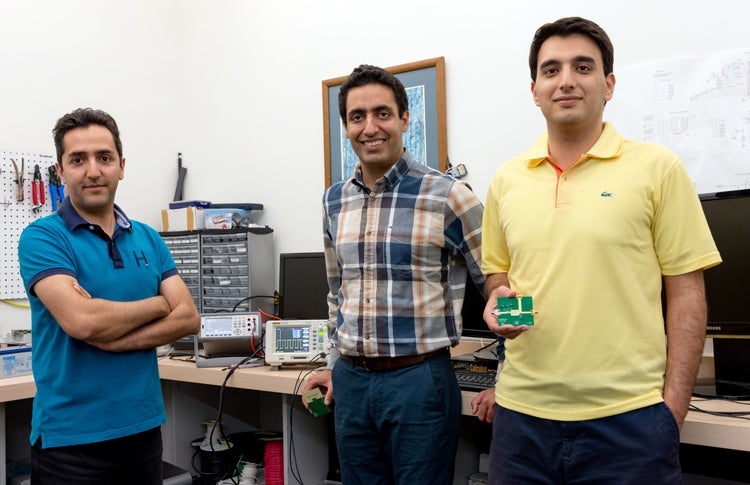More than 75 billion Internet of Things (IoT) devices are expected to be online by 2025. These connected devices will bring many new applications to our daily lives — everything from smart thermostats that sense and adjust room temperature independently, to cameras that monitor road congestion so traffic flows more efficiently, to high data rate sensors that will make self-driving cars possible.
But this massive influx of connected devices will strain our current wireless networks beyond their limit. Simply put, current WiFi and cellular networks won’t be able to support the increase in IoT devices.

L to R: Dr. Ali Abedi, Professor Omid Abari and master’s candidate Soroush Ameli. Mohammad Mazaheri, the lead researcher on this project, was unavailable for the photo.
Millimetre wave (mmWave)–based communication networks, which offer multi-gigahertz of unlicensed bandwidth — more than 200 times the amount allocated to today’s WiFi and cellular networks — could solve the congestion issue.
“It’s called mmWave because the signal frequency used for digital communication is extremely high. The higher the signal’s frequency, the shorter its wavelength — and for mmWave signals it’s on the order of millimetres,” explains Omid Abari, an assistant professor in the David R. Cheriton School of Computer Science. “A high frequency signal is needed for fast network communication and Internet connectivity but it comes at a cost. Short wavelength signals drop off quickly with distance. To compensate for that loss mmWave devices focus their radio signals into a narrow beam to make long-range communication possible.”
To do this, the mmWave node device has to move its beam electronically and scan for the location of the access point it communicates with. The hardware that does beam searching and alignment is both costly and consumes a lot of power. This makes mmWave both economically and technologically infeasible for many wireless IoT applications.
“We came up with a new idea,” said Ali Abedi, a lecturer and postdoctoral researcher in the Cheriton School of Computer Science’s ICON Lab. “We designed a new communication method and developed new hardware to get around the high cost and high energy consumption of traditional mmWave devices. The mmWave network we developed, which we call mmX, eliminates the need for beam searching and alignment in mmWave radios.”

The mmX platform. A node (L) transmits its data to an access point (R).
Traditional mmWave systems have viewed the quick attenuation of the high frequency mmWave signal as an undesirable phenomenon that the radio has to compensate for by using highly directional antennas.
“In contrast, we leveraged this directionality property as a way to modulate the signal over the air,” Omid Aberi explained. “Instead of modulating the signal first and then transmitting it to the beam with the best channel quality — the traditional mmWave communication approach — we intelligently transmit a signal to different beams. Each beam experiences a different amount of attenuation, and we use that to modulate the signal over the air. This method not only uses less power but at a cost that is less expensive than other mmWave platforms. Its substantially lower price and power consumption will open up entirely new applications.”
Compared with Bluetooth, which is slow for many IoT applications, mmX provides much higher bitrate, and compared with WiFi, mmX has much higher energy efficiency.
“mmX will improve not only our wireless experience, as we will receive much faster Internet connectivity for all IoT devices, but it can also be used in entirely new applications, such as untethered virtual reality, autonomous cars, and high-definition video cameras,” Ali Abedi said.
But as promising as mmX is for low cost and low power IoT devices, the research team is already eyeing two areas for improvement — increasing its data transmission speed and range.
“Right now, each mmX device can transmit about 100 million bits per second and has a range of 18 metres,” Omid Aberi said. “We are hoping to improve these two capabilities. And we also want to focus on the application side. Autonomous cars, for example, will need a huge number of linked sensors, which are currently connected by wire. With a platform like mmX, the sensors could be connected wirelessly to an access point in the car and work more reliably.”
A Millimeter Wave Network for Billions of Things, authored by Mohammed Mazaheri, Soroush Ameli, Ali Abedi and Omid Abari, which details this research, was recently published in SIGCOMM ‘19 Proceedings of the ACM Special Interest Group on Data Communication and presented at the ACM SIGCOMM 2019 conference in Beijing, China.